The Histone Demethylase HR Suppresses Breast Cancer Development through Enhanced CELF2 Tumor Suppressor Activity
Abstract
Simple Summary
Abstract
1. Introduction
2. Materials and Methods
2.1. Cell Culture and Transfection
2.2. Clinical Sample Information and Characteristics
2.3. Targeted Sequencing and CN Analysis
2.4. HR Reconstitution in HR-Deficient BC Cells
2.5. Cell Proliferation and Wound-Healing Assays
2.6. Clonogenic Assay
2.7. Mouse Xenograft Experiments
2.8. RNA Extraction, qRT-PCR, and RNA-Seq Analysis
2.9. Western Blotting and Immunofluorescence Staining
2.10. Variant Calling and Annotation, Bioinformatics, and Statistical Analysis
3. Results
3.1. Frequent HR Mutations in BC Tissues
3.2. HR Copy Number (CN) Loss Is Associated with an Increased Risk of Tumor Recurrence
3.3. HR Re-Expression Reduced Histone H3K9 Methylation in BC Cells as Well as Tumor Growth In Vivo
3.4. Identification of Target Genes Mediating the Antitumor Function of HR in MDA-MB-231 BC Cells
3.5. CELF2 Exhibits Potent Antitumor Activity in MDA-MB-231 Cells
4. Discussion
Supplementary Materials
Author Contributions
Funding
Institutional Review Board Statement
Informed Consent Statement
Data Availability Statement
Acknowledgments
Conflicts of Interest
References
- Siegel, R.L.; Miller, K.D.; Fuchs, H.E.; Jemal, A. Cancer statistics, 2021 (vol 71, pg 7, 2021). CA Cancer J. Clin. 2021, 71, 359. [Google Scholar] [CrossRef] [PubMed]
- Dai, X.; Cheng, H.; Bai, Z.; Li, J. Breast Cancer Cell Line Classification and Its Relevance with Breast Tumor Subtyping. J. Cancer 2017, 8, 3131–3141. [Google Scholar] [CrossRef] [PubMed]
- Ellis, M.J.; Perou, C.M. The Genomic Landscape of Breast Cancer as a Therapeutic Roadmap. Cancer Discov. 2013, 3, 27–34. [Google Scholar] [CrossRef]
- Apostolou, P.; Fostira, F. Hereditary Breast Cancer: The Era of New Susceptibility Genes. Biomed Res. Int. 2013, 2013, 747318. [Google Scholar] [CrossRef] [PubMed]
- Flavahan, W.A.; Gaskell, E.; Bernstein, B.E. Epigenetic plasticity and the hallmarks of cancer. Science 2017, 357, eaal2380. [Google Scholar] [CrossRef]
- Bernstein, B.E.; Meissner, A.; Lander, E.S. The mammalian epigenome. Cell 2007, 128, 669–681. [Google Scholar] [CrossRef] [PubMed]
- Chi, P.; Allis, C.D.; Wang, G.G. Covalent histone modifications—Miswritten, misinterpreted and mis-erased in human cancers. Nat. Rev. Cancer 2010, 10, 457–469. [Google Scholar] [CrossRef]
- Pedersen, M.T.; Helin, K. Histone demethylases in development and disease. Trends Cell Biol. 2010, 20, 662–671. [Google Scholar] [CrossRef]
- Feinberg, A.P.; Koldobskiy, M.A.; Gondor, A. Epigenetic modulators, modifiers and mediators in cancer aetiology and progression. Nat. Rev. Genet. 2016, 17, 284–299. [Google Scholar] [CrossRef]
- Albert, M.; Helin, K. Histone methyltransferases in cancer. Semin. Cell Dev. Biol. 2010, 21, 209–220. [Google Scholar] [CrossRef]
- D’Oto, A.; Tian, Q.-W.; Davidoff, A.M.; Yang, J. Histone demethylases and their roles in cancer epigenetics. J. Med. Oncol. Ther. 2016, 1, 34–40. [Google Scholar] [CrossRef] [PubMed]
- Michalak, E.M.; Visvader, J.E. Dysregulation of histone methyltransferases in breast cancer—Opportunities for new targeted therapies? Mol. Oncol. 2016, 10, 1497–1515. [Google Scholar] [CrossRef] [PubMed]
- Shinkai, Y.; Tachibana, M. H3K9 methyltransferase G9a and the related molecule GLP. Genes Dev. 2011, 25, 781–788. [Google Scholar] [CrossRef] [PubMed]
- Trager, M.H.; Sah, B.; Chen, Z.; Liu, L. Control of Breast Cancer Pathogenesis by Histone Methylation and the Hairless Histone Demethylase. Endocrinology 2021, 162, bqab088. [Google Scholar] [CrossRef] [PubMed]
- Potter, G.B.; Beaudoin, G.M.J.; DeRenzo, C.L.; Zarach, J.M.; Chen, S.H.; Thompson, C.C. The hairless gene mutated in congenital hair loss disorders encodes a novel nuclear receptor corepressor. Genes Dev. 2001, 15, 2687–2701. [Google Scholar] [CrossRef]
- Ahmad, W.; Haque, W.F.U.; Brancolini, V.; Tsou, H.C.; Haque, S.U.; Lam, H.; Aita, V.M.; Owen, J.; deBlaquiere, M.; Frank, J.; et al. Alopecia universalis associated with a mutation in the human hairless gene. Science 1998, 279, 720–724. [Google Scholar] [CrossRef]
- Thompson, C.C. Hairless is a nuclear receptor corepressor essential for skin function. Nucl. Recept. Signal. 2009, 7, e010. [Google Scholar] [CrossRef]
- Cloos, P.A.; Christensen, J.; Agger, K.; Helin, K. Erasing the methyl mark: Histone demethylases at the center of cellular differentiation and disease. Genes Dev. 2008, 22, 1115–1140. [Google Scholar] [CrossRef]
- Liu, L.; Kim, H.; Casta, A.; Kobayashi, Y.; Shapiro, L.S.; Christiano, A.M. Hairless is a histone H3K9 demethylase. FASEB J. 2014, 28, 1534–1542. [Google Scholar] [CrossRef]
- Barski, A.; Cuddapah, S.; Cui, K.; Roh, T.Y.; Schones, D.E.; Wang, Z.; Wei, G.; Chepelev, I.; Zhao, K. High-resolution profiling of histone methylations in the human genome. Cell 2007, 129, 823–837. [Google Scholar] [CrossRef]
- Kim, H.; Casta, A.; Tang, X.W.; Luke, C.T.; Kim, A.L.; Bickers, D.R.; Athar, M.; Christiano, A.M. Loss of Hairless Confers Susceptibility to UVB-Induced Tumorigenesis via Disruption of NF-κB Signaling. PLoS ONE 2012, 7, e39691. [Google Scholar] [CrossRef] [PubMed][Green Version]
- Aziz, M.H.; Sundling, K.E.; Dreckschmidt, N.E.; Verma, A.K. Protein kinase Cepsilon inhibits UVR-induced expression of FADD, an adaptor protein, linked to both Fas- and TNFR1-mediated apoptosis. J. Investig. Derm. 2009, 129, 2011–2021. [Google Scholar] [CrossRef] [PubMed][Green Version]
- Buyru, N.; Baltaci, E.; Yavuz, E.; Seven, D.; Kilic, E.; Karaman, E. Downregulation of the DLEC1 gene is not associated with promoter methylation in head and neck cancer. Eur. J. Cancer 2014, 50, S93. [Google Scholar] [CrossRef]
- Ying, J.; Poon, F.F.; Yu, J.; Geng, H.; Wong, A.H.Y.; Qiu, G.H.; Goh, H.K.; Rha, S.Y.; Tian, L.; Chan, A.T.C.; et al. DLEC1 is a functional 3p22.3 tumour suppressor silenced by promoter CpG methylation in colon and gastric cancers. Br. J. Cancer 2009, 100, 663–669. [Google Scholar] [CrossRef]
- Feng, Z.E.; Li, J.N.; Wang, L.; Pu, Y.F.; Wang, Y.X.; Guo, C.B. The prognostic value of glycerol-3-phosphate dehydrogenase 1-like expression in head and neck squamous cell carcinoma. Histopathology 2014, 64, 348–355. [Google Scholar] [CrossRef] [PubMed]
- Kelly, T.J.; Souza, A.L.; Clish, C.B.; Puigserver, P. A Hypoxia-Induced Positive Feedback Loop Promotes Hypoxia-Inducible Factor 1 alpha Stability through miR-210 Suppression of Glycerol-3-Phosphate Dehydrogenase 1-Like. Mol. Cell Biol. 2011, 31, 2696–2706. [Google Scholar] [CrossRef]
- Maatough, A.; Whitfield, G.K.; Brook, L.; Hsieh, D.; Palade, P.; Hsieh, J.C. Human Hairless Protein Roles in Skin/Hair and Emerging Connections to Brain and Other Cancers. J. Cell Biochem. 2018, 119, 69–80. [Google Scholar] [CrossRef]
- Dai, X.F.; Li, T.; Bai, Z.H.; Yang, Y.K.; Liu, X.X.; Zhan, J.L.; Shi, B.Z. Breast cancer intrinsic subtype classification, clinical use and future trends. Am. J. Cancer Res. 2015, 5, 2929–2943. [Google Scholar]
- Ahn, H.J.; Jung, S.J.; Kim, T.H.; Oh, M.K.; Yoon, H.K. Differences in Clinical Outcomes between Luminal A and B Type Breast Cancers according to the St. Gallen Consensus 2013. J. Breast Cancer 2015, 18, 149–159. [Google Scholar] [CrossRef]
- Shen, Y.; Kim, A.L.; Du, R.; Liu, L. Transcriptome Analysis Identifies the Dysregulation of Ultraviolet Target Genes in Human Skin Cancers. PLoS ONE 2016, 11, e0163054. [Google Scholar] [CrossRef]
- Ha, W.; Hinde, A.; Xie, L.; Trager, M.H.; Liu, L. Biomarker function of HMGA2 in ultraviolet-induced skin cancer development. Exp. Dermatol. 2020, 29, 1021–1026. [Google Scholar] [CrossRef] [PubMed]
- Liu, L.; Rezvani, H.R.; Back, J.H.; Hosseini, M.; Tang, X.; Zhu, Y.; Mahfouf, W.; Raad, H.; Raji, G.; Athar, M.; et al. Inhibition of p38 MAPK signaling augments skin tumorigenesis via NOX2 driven ROS generation. PLoS ONE 2014, 9, e97245. [Google Scholar] [CrossRef] [PubMed]
- Anders, S.; Huber, W. Differential expression analysis for sequence count data. Genome Biol 2010, 11, R106. [Google Scholar] [CrossRef] [PubMed]
- Wang, K.; Li, M.Y.; Hakonarson, H. ANNOVAR: Functional annotation of genetic variants from high-throughput sequencing data. Nucleic Acids Res. 2010, 38, e164. [Google Scholar] [CrossRef] [PubMed]
- Mayakonda, A.; Lin, D.C.; Assenov, Y.; Plass, C.; Koeffler, H.P. Maftools: Efficient and comprehensive analysis of somatic variants in cancer. Genome Res. 2018, 28, 1747–1756. [Google Scholar] [CrossRef]
- Wickham, H. ggplot2: Elegant Graphics for Data Analysis. In Use R; Springer: Berlin/Heidelberg, Germany, 2009; pp. 1–212. [Google Scholar]
- Zhang, Y.; Xiong, S.; Liu, B.; Pant, V.; Celii, F.; Chau, G.; Elizondo-Fraire, A.C.; Yang, P.; You, M.J.; El-Naggar, A.K.; et al. Somatic Trp53 mutations differentially drive breast cancer and evolution of metastases. Nat. Commun. 2018, 9, 3953. [Google Scholar] [CrossRef]
- Darb-Esfahani, S.; Denkert, C.; Stenzinger, A.; Salat, C.; Sinn, B.; Schem, C.; Endris, V.; Klare, P.; Schmitt, W.; Blohmera, J.U.; et al. Role of TP53 mutations in triple negative and HER2-positive breast cancer treated with neoadjuvant anthracycline/taxane-based chemotherapy. Oncotarget 2016, 7, 67686–67698. [Google Scholar] [CrossRef]
- Abubakar, M.; Guo, C.Y.; Koka, H.; Sung, H.; Shao, N.; Guida, J.; Deng, J.; Li, M.J.; Hu, N.; Zhou, B.; et al. Clinicopathological and epidemiological significance of breast cancer subtype reclassification based on p53 immunohistochemical expression. NPJ Breast Cancer 2019, 5, 20. [Google Scholar] [CrossRef]
- Donehower, L.A.; Soussi, T.; Korkut, A.; Liu, Y.; Schultz, A.; Cardenas, M.; Li, X.; Babur, O.; Hsu, T.K.; Lichtarge, O.; et al. Integrated Analysis of TP53 Gene and Pathway Alterations in The Cancer Genome Atlas. Cell Rep. 2019, 28, 3010. [Google Scholar] [CrossRef]
- Barretina, J.; Caponigro, G.; Stransky, N.; Venkatesan, K.; Margolin, A.A.; Kim, S.; Wilson, C.J.; Lehar, J.; Kryukov, G.V.; Sonkin, D.; et al. The Cancer Cell Line Encyclopedia enables predictive modelling of anticancer drug sensitivity. Nature 2012, 483, 603–607. [Google Scholar] [CrossRef]
- Jiang, G.L.; Zhang, S.J.; Yazdanparast, A.; Li, M.; Pawar, A.V.; Liu, Y.L.; Inavolu, S.M.; Cheng, L.J. Comprehensive comparison of molecular portraits between cell lines and tumors in breast cancer. BMC Genom. 2016, 17, 281–301. [Google Scholar] [CrossRef] [PubMed]
- Kaniskan, H.U.; Jin, J. Recent progress in developing selective inhibitors of protein methyltransferases. Curr. Opin. Chem. Biol. 2017, 39, 100–108. [Google Scholar] [CrossRef] [PubMed]
- Yeung, Y.T.; Fan, S.; Lu, B.; Yin, S.; Yang, S.; Nie, W.; Wang, M.; Zhou, L.; Li, T.; Li, X.; et al. CELF2 suppresses non-small cell lung carcinoma growth by inhibiting the PREX2-PTEN interaction. Carcinogenesis 2020, 41, 377–389. [Google Scholar] [CrossRef]
- Pique, L.; de Paz, A.M.; Pineyro, D.; Martinez-Cardus, A.; de Moura, M.C.; Llinas-Arias, P.; Setien, F.; Gomez-Miragaya, J.; Gonzalez-Suarez, E.; Sigurdsson, S.; et al. Epigenetic inactivation of the splicing RNA-binding protein CELF2 in human breast cancer. Oncogene 2019, 38, 7106–7112. [Google Scholar] [CrossRef]
- Cai, Y.; Crowther, J.; Pastor, T.; Abbasi Asbagh, L.; Baietti, M.F.; De Troyer, M.; Vazquez, I.; Talebi, A.; Renzi, F.; Dehairs, J.; et al. Loss of Chromosome 8p Governs Tumor Progression and Drug Response by Altering Lipid Metabolism. Cancer Cell 2016, 29, 751–766. [Google Scholar] [CrossRef] [PubMed]
- Huovinen, M.; Loikkanen, J.; Myllynen, P.; Vahakangas, K.H. Characterization of human breast cancer cell lines for the studies on p53 in chemical carcinogenesis. Toxicol. Vitr. 2011, 25, 1007–1017. [Google Scholar] [CrossRef]
- Silwal-Pandit, L.; Vollan, H.K.; Chin, S.F.; Rueda, O.M.; McKinney, S.; Osako, T.; Quigley, D.A.; Kristensen, V.N.; Aparicio, S.; Borresen-Dale, A.L.; et al. TP53 mutation spectrum in breast cancer is subtype specific and has distinct prognostic relevance. Clin. Cancer Res. 2014, 20, 3569–3580. [Google Scholar] [CrossRef]
- Park, M.H.; Kim, S.Y.; Kim, Y.J.; Chung, Y.H. ALS2CR7 (CDK15) attenuates TRAIL induced apoptosis by inducing phosphorylation of survivin Thr34. Biochem. Biophys. Res. Commun. 2014, 450, 129–134. [Google Scholar] [CrossRef]
- Li, S.; Dai, X.; Gong, K.; Song, K.; Tai, F.; Shi, J. PA28alpha/beta Promote Breast Cancer Cell Invasion and Metastasis via Down-Regulation of CDK15. Front. Oncol 2019, 9, 1283. [Google Scholar] [CrossRef]
- Xia, Y.; Shen, S.; Verma, I.M. NF-κB, an active player in human cancers. Cancer Immunol. Res. 2014, 2, 823–830. [Google Scholar] [CrossRef]
- Zhu, K.; Xu, C.; Liu, M.; Zhang, J. Hairless controls hair fate decision via Wnt/β–catenin signaling. Biochem. Biophys. Res. Commun. 2017, 491, 567–570. [Google Scholar] [CrossRef] [PubMed]
- Brook, L.; Palade, P.; Maatough, A.; Whitfield, G.K.; Emeterio, L.S.; Hsieh, D.; Hsieh, J.C. Hairless regulates p53 target genes to exert tumor suppressive functions in glioblastoma. J. Cell Biochem. 2019, 120, 533–543. [Google Scholar] [CrossRef] [PubMed]
- Brook, L.; Whitfield, G.K.; Hsieh, D.; Bither, R.D.; Hsieh, J.C. The Mammalian Hairless Protein as a DNA Binding Phosphoprotein. J. Cell. Biochem. 2017, 118, 341–350. [Google Scholar] [CrossRef] [PubMed]
- Chuma, M.; Endo-Umeda, K.; Shimba, S.; Yamada, S.; Makishima, M. Hairless modulates ligand-dependent activation of the vitamin D receptor-retinoid X receptor heterodimer. Biol. Pharm. Bull. 2012, 35, 582–587. [Google Scholar] [CrossRef]
- Zarach, J.M.; Beaudoin, G.M.J.; Coulombe, P.A.; Thompson, C.C. The co-repressor hairless has a role in epithelial cell differentiation in the skin. Development 2004, 131, 4189–4200. [Google Scholar] [CrossRef]
- Tu, W.B.; Shiah, Y.J.; Lourenco, C.; Mullen, P.J.; Dingar, D.; Redel, C.; Tamachi, A.; Ba-Alawi, W.; Aman, A.; Al-awar, R.; et al. MYC Interacts with the G9a Histone Methyltransferase to Drive Transcriptional Repression and Tumorigenesis. Cancer Cell 2018, 34, 579–595. [Google Scholar] [CrossRef] [PubMed]
- Wang, Y.F.; Zhang, J.; Su, Y.; Shen, Y.Y.; Jiang, D.X.; Hou, Y.Y.; Geng, M.Y.; Ding, J.; Chen, Y. G9a regulates breast cancer growth by modulating iron homeostasis through the repression of ferroxidase hephaestin. Nat. Commun. 2017, 8, 274. [Google Scholar] [CrossRef]
- Huang, J.; Dorsey, J.; Chuikov, S.; Zhang, X.Y.; Jenuwein, T.; Reinberg, D.; Berger, S.L. G9a and Glp Methylate Lysine 373 in the Tumor Suppressor p53. J. Biol. Chem. 2010, 285, 9636–9641. [Google Scholar] [CrossRef]
- Mabe, N.W.; Garcia, N.M.G.; Wolery, S.E.; Newcomb, R.; Meingasner, R.C.; Vilona, B.A.; Lupo, R.; Lin, C.C.; Chi, J.T.; Alvarez, J.V. G9a Promotes Breast Cancer Recurrence through Repression of a Pro-inflammatory Program. Cell Rep. 2020, 33, 108341. [Google Scholar] [CrossRef]
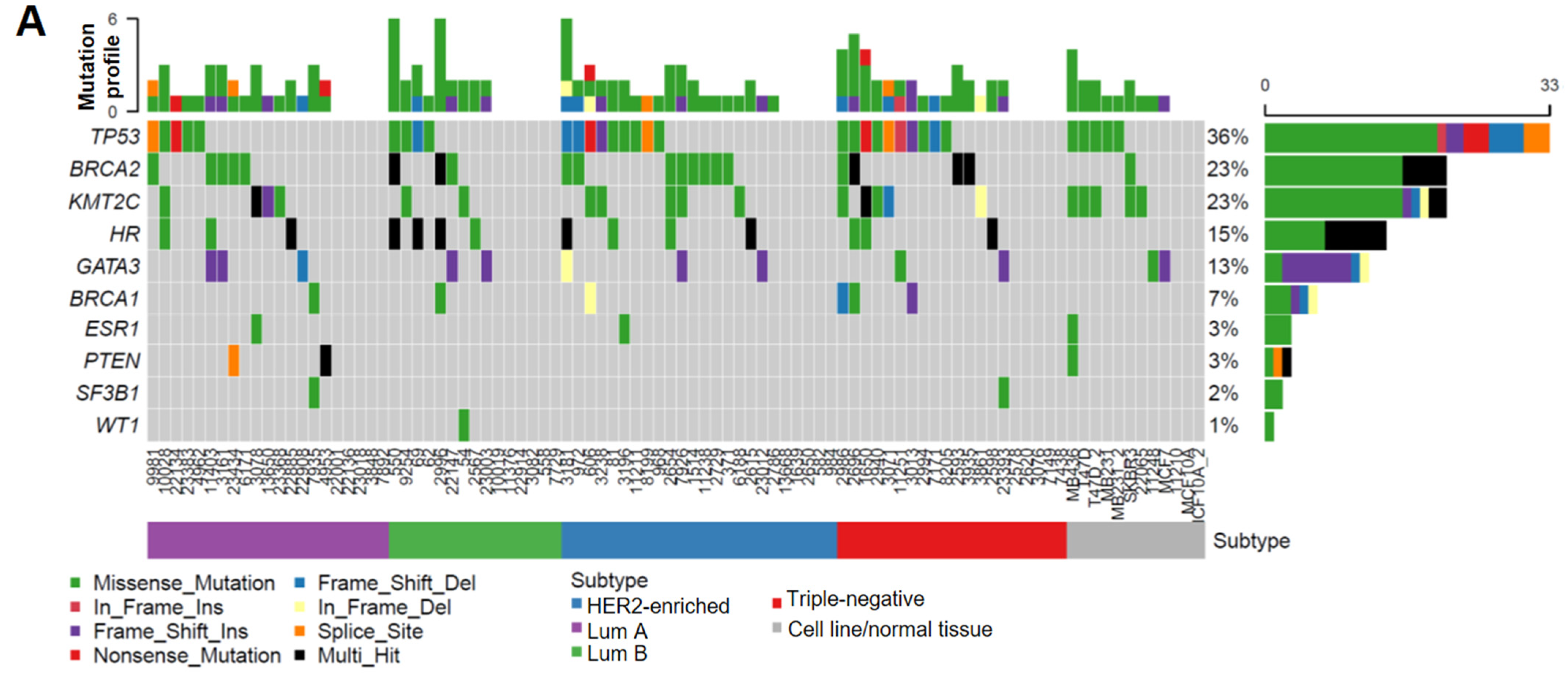
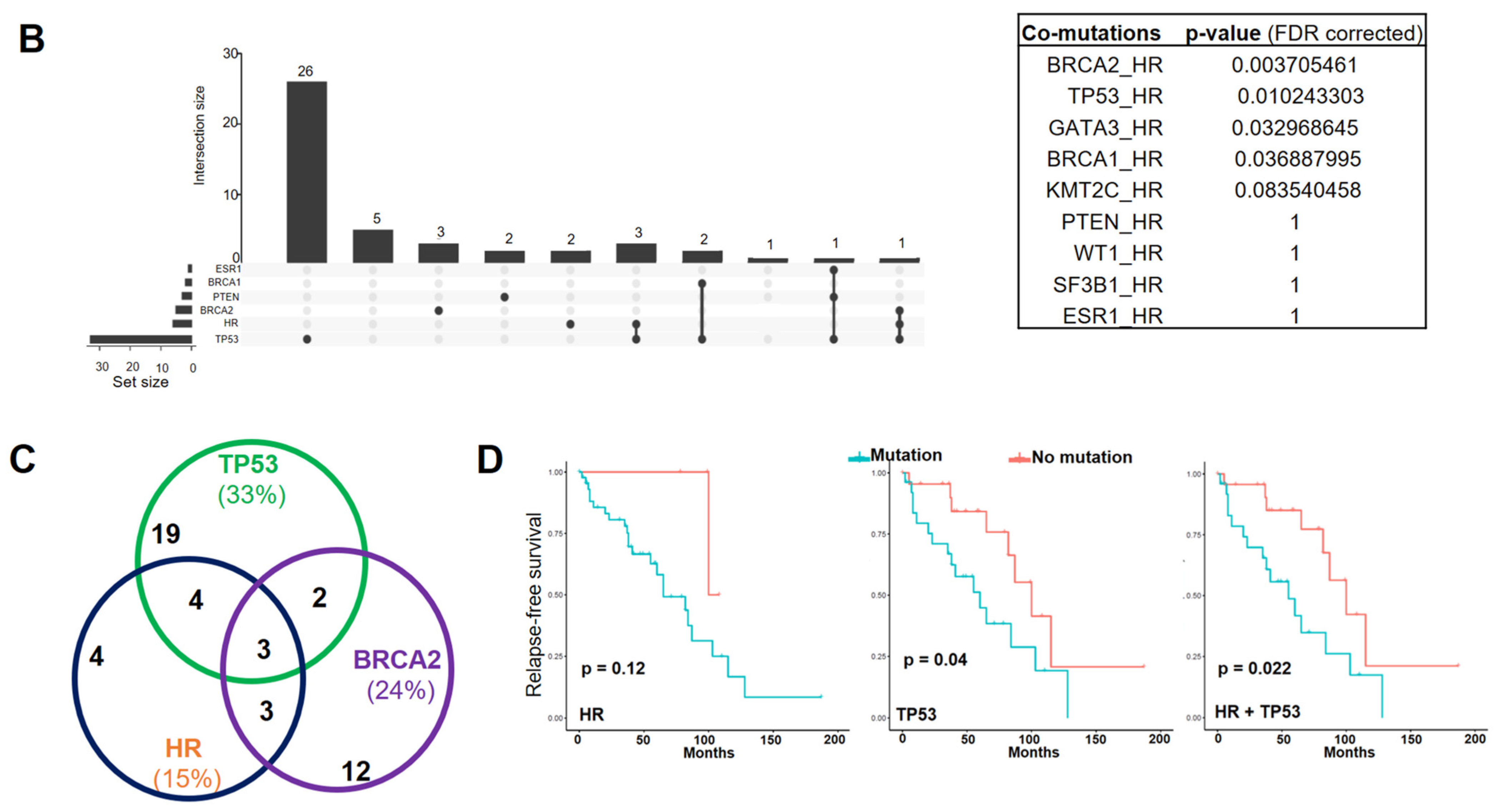
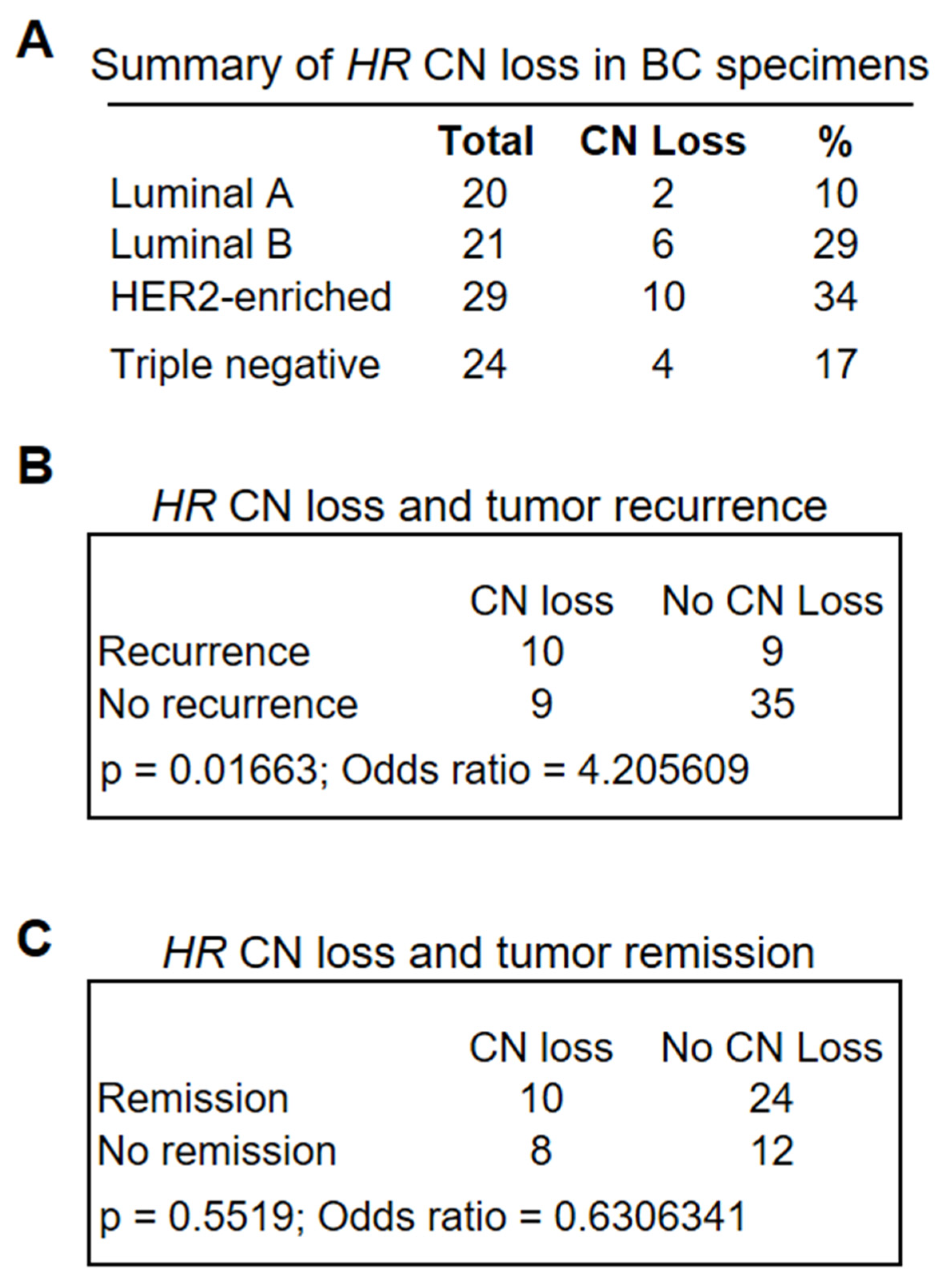
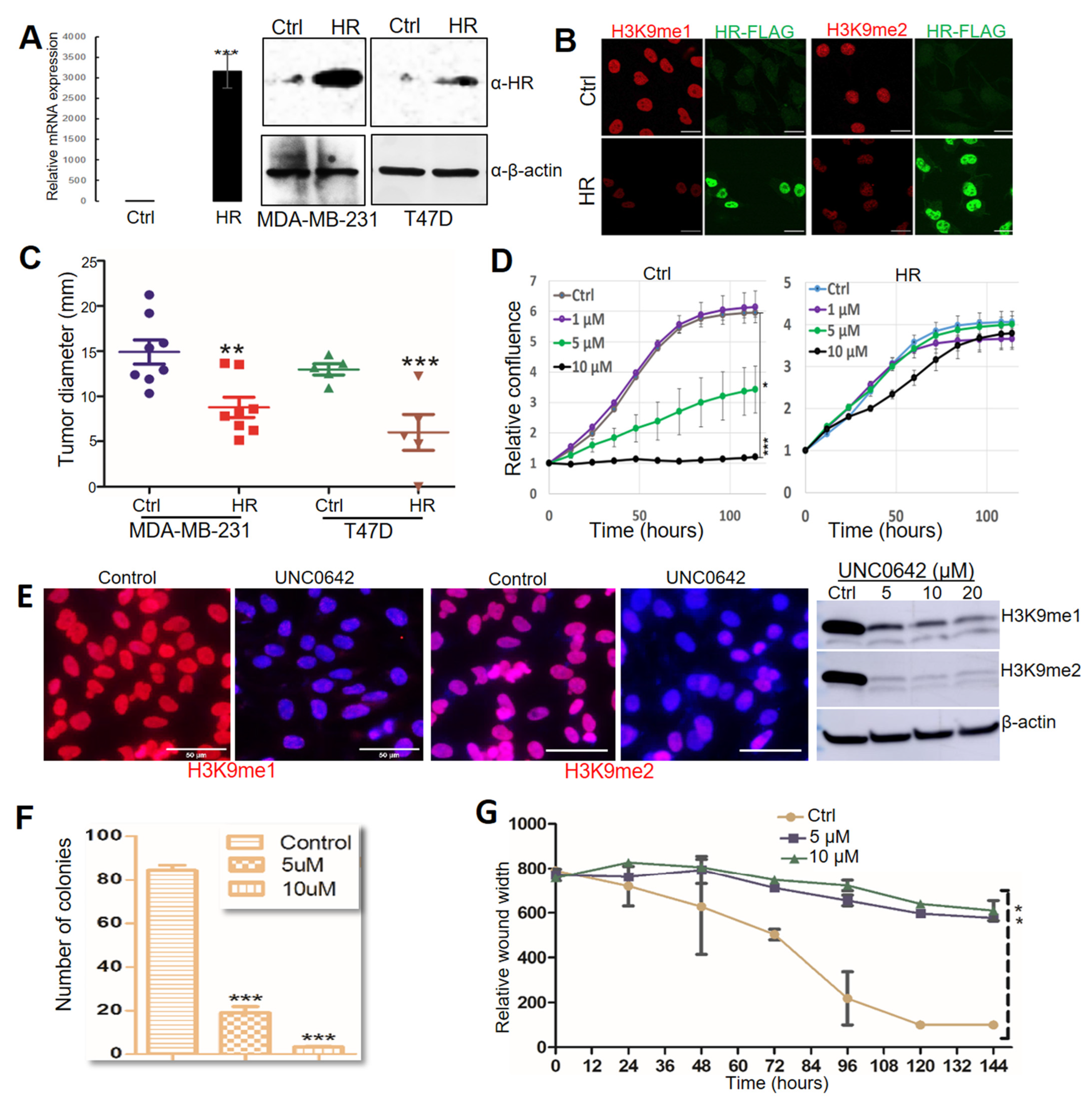
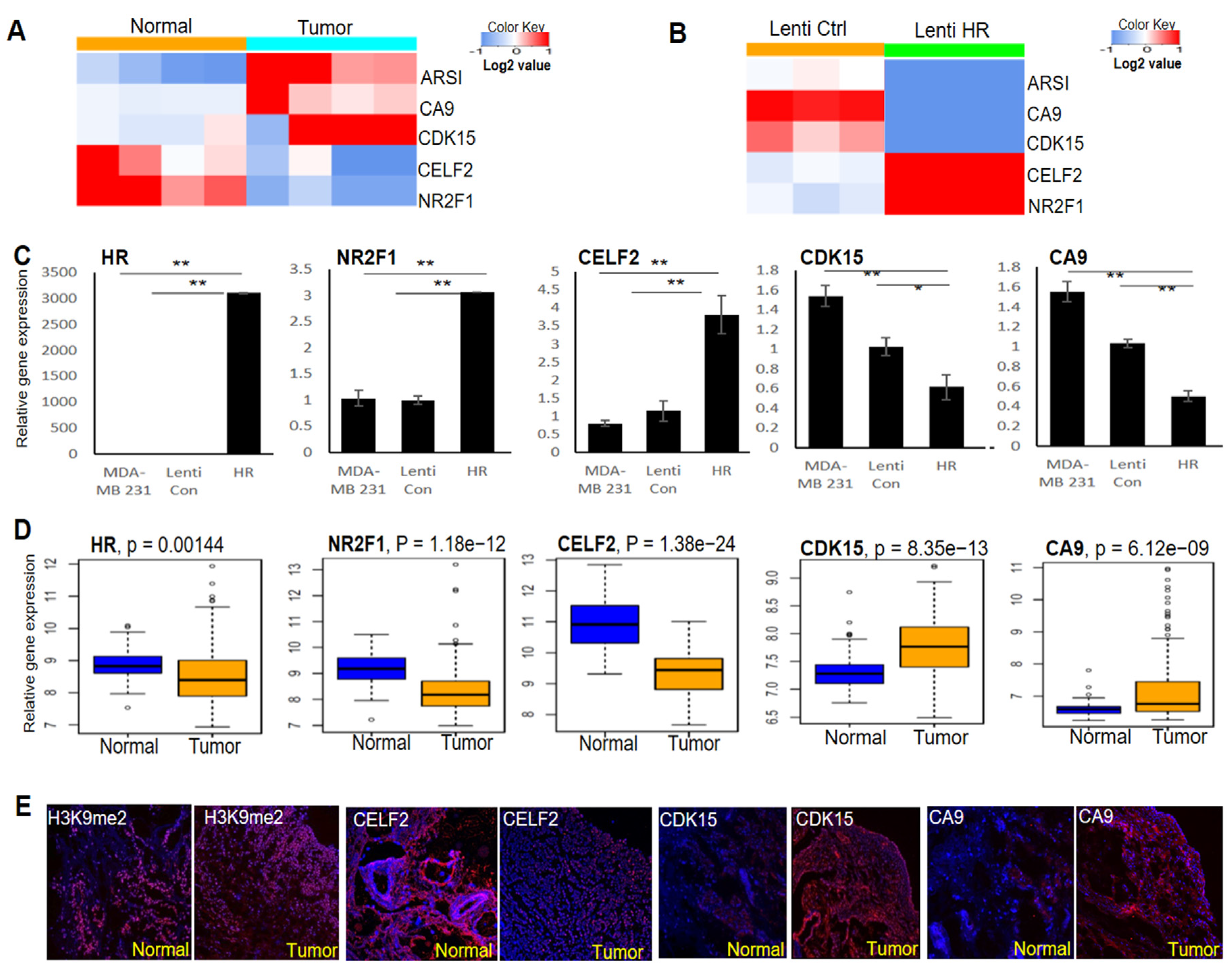
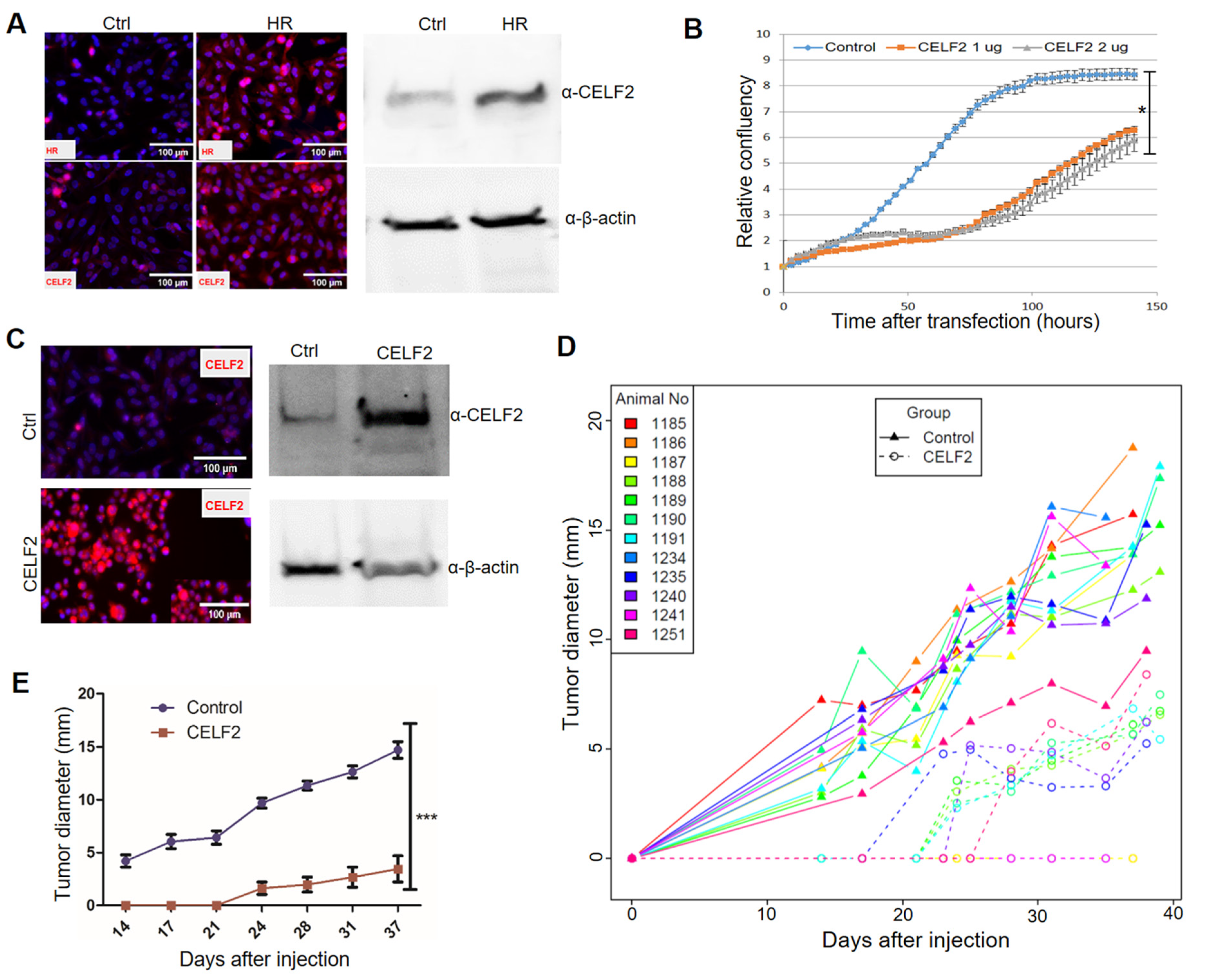
| Lum A | Lum B | HER2 Enriched | TNBC | Cell Lines | |
|---|---|---|---|---|---|
| Total | 21 | 16 | 24 | 20 | 5 |
| HR | 3 | 4 | 4 | 3 | 0 |
| TP53 | 5 | 4 | 9 | 10 | 3 |
| BRCA2 | 5 | 3 | 8 | 4 | 1 |
| KMT2C | 4 | 2 | 5 | 5 | 3 |
| GATA3 | 3 | 2 | 3 | 2 | 1 |
| BRCA1 | 1 | 1 | 1 | 3 | 0 |
| ESR1 | 1 | 0 | 1 | 0 | 1 |
| PTEN | 2 | 0 | 0 | 0 | 1 |
| SF3B1 | 1 | 0 | 0 | 1 | 0 |
| WT1 | 0 | 1 | 0 | 0 | 0 |
Publisher’s Note: MDPI stays neutral with regard to jurisdictional claims in published maps and institutional affiliations. |
© 2022 by the authors. Licensee MDPI, Basel, Switzerland. This article is an open access article distributed under the terms and conditions of the Creative Commons Attribution (CC BY) license (https://creativecommons.org/licenses/by/4.0/).
Share and Cite
Shen, Y.; Singh, J.; Sah, B.; Chen, Z.; Ha, W.; Henzler, C.; Su, T.; Xie, L.; Deng, Y.; Li, G.; et al. The Histone Demethylase HR Suppresses Breast Cancer Development through Enhanced CELF2 Tumor Suppressor Activity. Cancers 2022, 14, 4648. https://doi.org/10.3390/cancers14194648
Shen Y, Singh J, Sah B, Chen Z, Ha W, Henzler C, Su T, Xie L, Deng Y, Li G, et al. The Histone Demethylase HR Suppresses Breast Cancer Development through Enhanced CELF2 Tumor Suppressor Activity. Cancers. 2022; 14(19):4648. https://doi.org/10.3390/cancers14194648
Chicago/Turabian StyleShen, Yao, Jasvinder Singh, Bindeshwar Sah, Zhongming Chen, Wootae Ha, Christine Henzler, Tao Su, Lillian Xie, Yibin Deng, Gen Li, and et al. 2022. "The Histone Demethylase HR Suppresses Breast Cancer Development through Enhanced CELF2 Tumor Suppressor Activity" Cancers 14, no. 19: 4648. https://doi.org/10.3390/cancers14194648
APA StyleShen, Y., Singh, J., Sah, B., Chen, Z., Ha, W., Henzler, C., Su, T., Xie, L., Deng, Y., Li, G., Guo, H., Hibshoosh, H., & Liu, L. (2022). The Histone Demethylase HR Suppresses Breast Cancer Development through Enhanced CELF2 Tumor Suppressor Activity. Cancers, 14(19), 4648. https://doi.org/10.3390/cancers14194648






